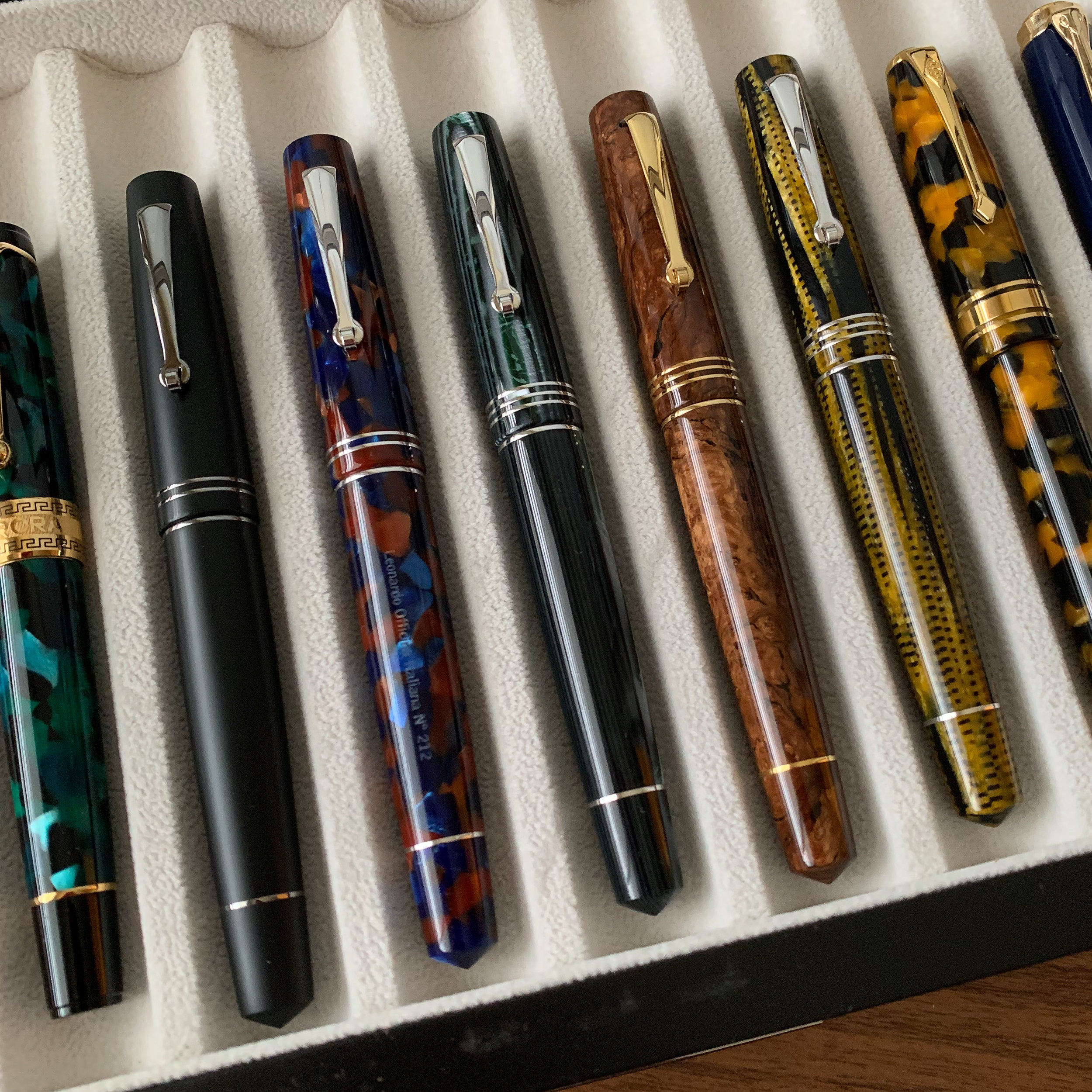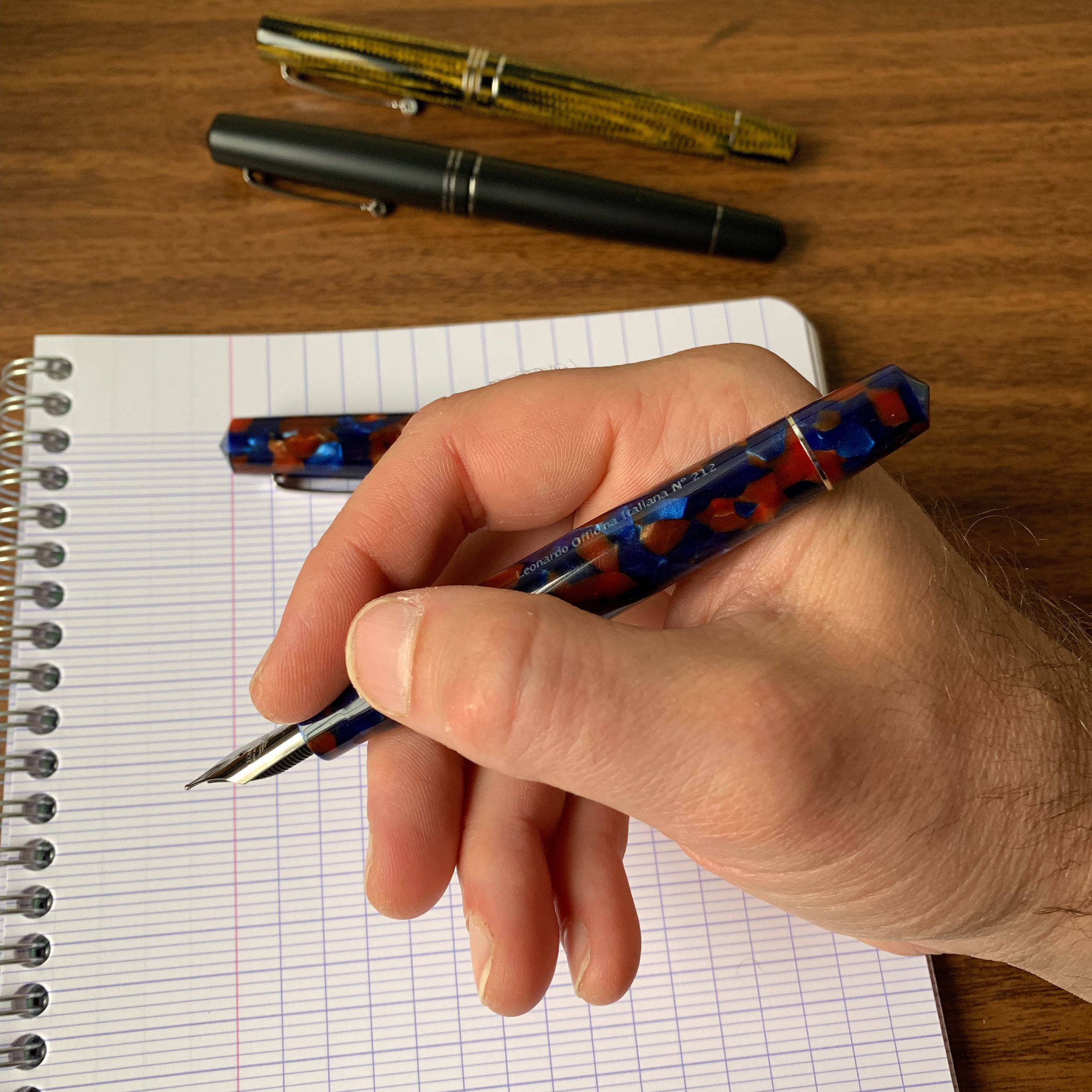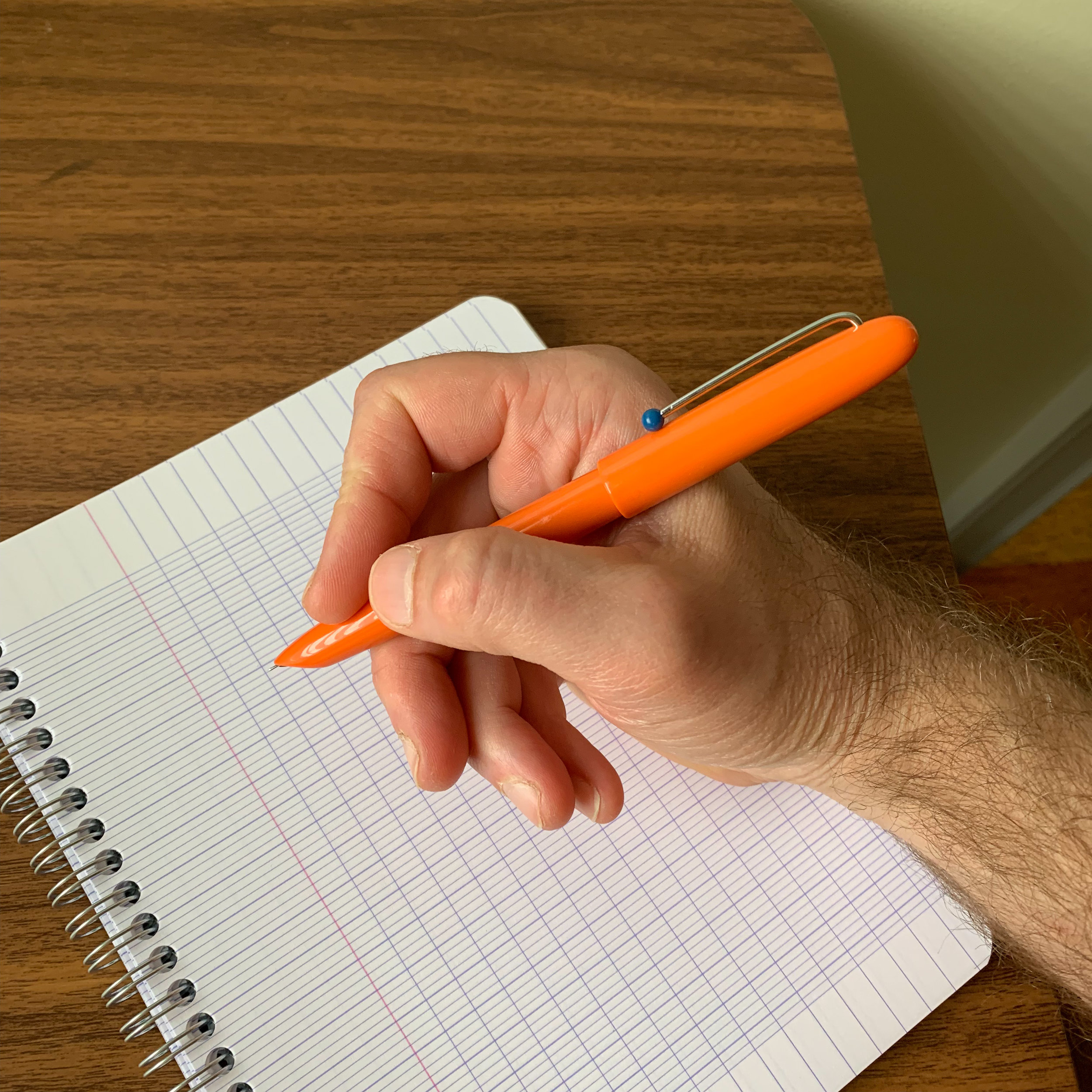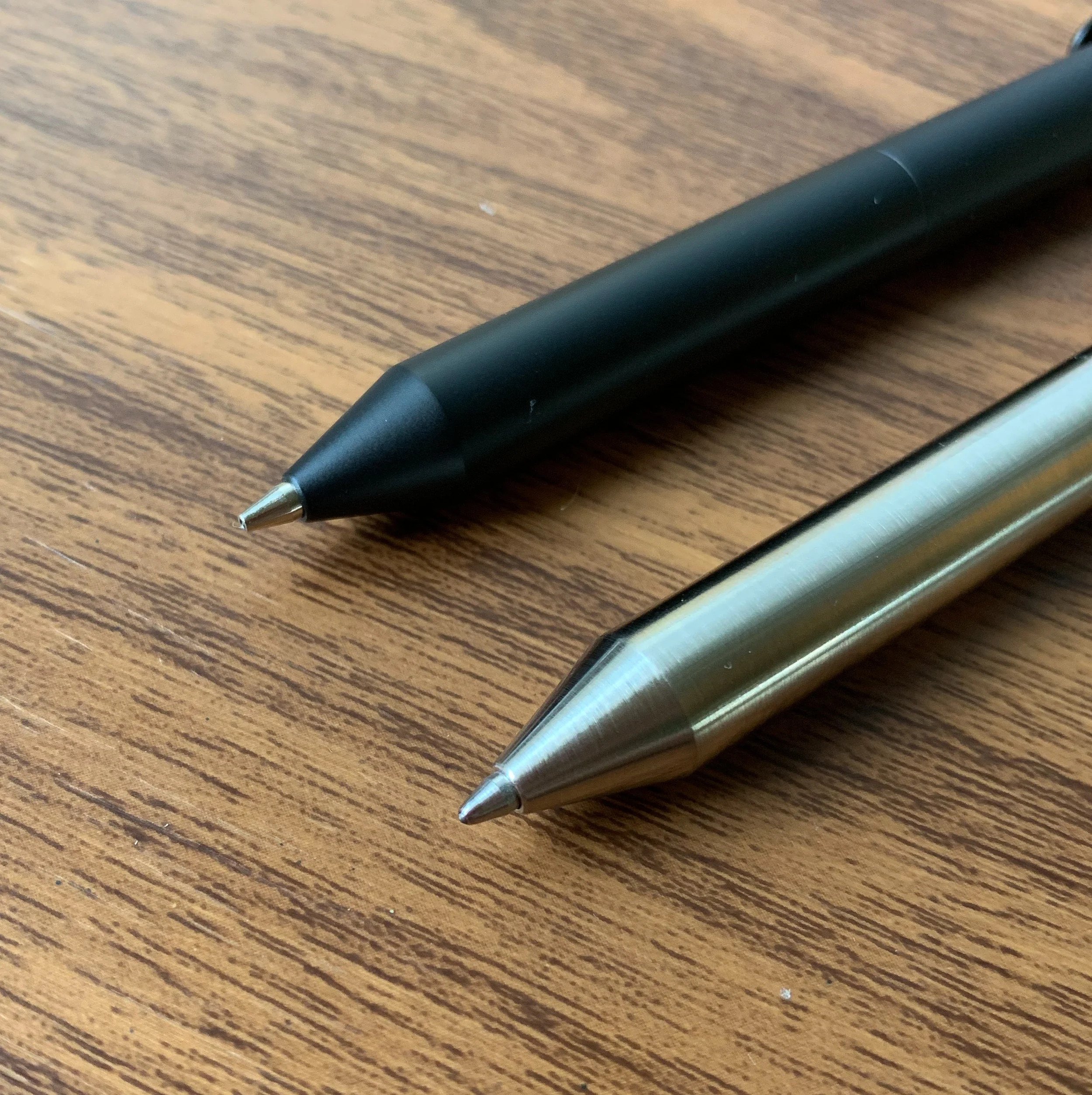It's definitely true that some reviews write themselves, and others take a longer time to develop. Not because of any ambivalence about the pen itself - no, from the minute I picked up a Leonardo Momento Zero (and possibly from the minute I first saw the pictures online) I knew that this would be a pen for me. Nevertheless, it’s taken me a while to put this review together, if for no other reason that it takes some time to photograph five pens!
I don't know all the details of the story behind the founding of Leonardo Officina Italiana, but from what I can piece together from conversations I've had at pen shows and brand descriptions, Leonardo was founded by former penmakers at Delta, the now-defunct Italian company. Though Delta took a lot of flack for a tendency towards gaudy special editions and marketing gimmicks (fusion nib, anyone?), I could never argue with the actual writing experience that their pens offered. Montegrappa was far outside my price point; Omas was plagued with nib issues and just wrote too wet in general, leaving Delta and Aurora as the pens for people who actually want to use their pens for work. Of course, in the years since I've entered this hobby, both Delta and Omas are now defunct, and Aurora and Montegrappa have both made strides in making their products both more accessible and useable as daily writers. That said, I still feel the loss of Delta, and it left a void, especially for those of us who prized celluloid pens.
The work Leonardo has done in Italian celluloid is what initially drew me to the brand. The three pens in the center are the piston-filler Momento Zero in, from left, Omas Arco Verde celluloid, Omas Burlwood celluloid, and Omas Burkina celluloid.
Originally, before launching their own pens, Leonardo was a workshop that partnered with Armando Simoni Club, which had purchased certain assets of Omas (most notably, their remaining stock of celluloid rods). It is my understanding that the same penmakers behind Leonardo manufacture most of the ASC pens, which have received very good reviews in their own right, though their size, design, and price point target a vary specific customer.
The only other acrylic material in my collection that captures the depth of the material Leonardo uses has been from Conway Stewart. Shown here is the Conway Stewart Model 100 in “Honey Noire,” next to the Momento Zero in Pietra Marina (“Sea Stone”) acrylic.
Last year, Leonardo began releasing pens under their own name. The first model, the Momento Zero, took some time to "gather momentum," for lack of a better expression, because the pen was initially produced in small quantities, and not heavily promoted. I'm not sure of the official order of release, but the first Momento Zero pens I recall seeing available for sale were the "Abyss Celluloid" releases, which commanded a high price and sold quickly. As production ramped up, Leonardo not only released additional higher-priced celluloid and ebonite pens in a range of different (and beautiful) materials, but expanded the Momento Zero lineup to include acrylic pens at the $160-$200 price point, which is when I really became interested. They even included a matte black pen with ruthenium trim, which is good enough to give the Sailor Pro Gear Imperial Black a run for its money, especially as a price/value proposition.
The next generation of Italian pens: from the Delta Fusion 82 to the Leonardo Momento Zero.
I Take the Plunge (or Jump Off the Cliff)
I didn't start with the standard lineup, though. Though I was never a fan of Omas pens from a usability perspective, I had long admired their materials and design - especially their celluloids. When I saw the Leonardo "Maestro" set, consisting of three Momento Zeroes in long-discontinued Omas Burkina, Arco Verde, and Burlwood celluloids, I knew that I'd have to sell some pens and pick up a set. Unfortunately, by the time I'd sold enough pens to pay for most of the purchase, nearly all retailers had already sold out, except for one set still held by Emil at Pen Venture. You can say that I liked the size and shape of these pens - since then I've acquired two more Momento Zeroes from the standard "production line," and will likely add additional pens in the future.
The Leonardo Momento Zero “Maestro” set in its presentation box. Each of these pens arrived in impeccable condition with nibs tuned to perfection.
What Do I Like So Much about the Momento Zero?
The Leonardo Momento Zero wins big in all the major categories that I look at when selecting and buying a pen.
Balance and Writing Comfort. Perhaps most importantly, the pen is perfectly sized and balanced for my hand - neither too long nor too short, and I can easily use it posted or unposted. The only other pens that hit this same sweet spot are the Montblanc 146 and, sadly, the Delta Fusion 82, which no longer exists (though one remains in my collection). The Leonardo feels most like the 146 in my hand, since the barrel is wider than the Fusion 82, though it’s much lighter due to the absence of a brass piston.
Classic Design. In terms of design, Leonardo has definitely gone for the classic look. The shape somewhat reminds me of a Sailor Pro Gear, but slightly larger with peaked ends reminiscent of a Nakaya Piccolo or Long Piccolo. All of the materials - acrylic, celluloid, or ebonite - exude a vintage vibe and have excellent depth to the various patterns, and Leonardo uses simple, understated trim to avoid the trap that Delta and Omas sometimes fell into, which is making the pens too flashy or “busy” in an effort to create a unique look.
Well-Tuned Nibs. The Momento Zero features standard Bock nibs that have been personalized with the Leonardo logo, and I suspect have been tuned and set at the factory. The higher-priced celluloid and ebonite pens feature 14kt gold nibs on an ebonite feed, with steel nibs and plastic feeds on the production line pens. Overall, I've had excellent luck with the nibs on my Leonardos. Emil tuned the gold nibs on my Maestro set to perfection, and the steel nibs on the pens from the standard lineup performed perfectly well out of the box. Since any Bock nibs have the potential for quality control issues, I would recommend purchasing from a retailer who will check and, if necessary, tune the nib for you, unless you are comfortable doing the work yourself or plan to get the nib ground or tuned at a pen show.
Overall Build Quality. If you’ve used a lot of fountain pens, you’ll know what I’m talking about when I say that you can “feel” whether a pen is well-made or not. The Momento Zero feels great. These pens have been hand-turned, and to achieve this level of consistency requires years of experience and a lot of care. Another nice touch is the filling system: My celluloid Maestro pens feature a lightweight integrated piston, and while the acrylic models are cartridge-converter, the converter is semi-integrated in that it not only threads into the section, but has a metal-plated knob at the end that extends out the back of the barrel. If you don’t feel like unscrewing the section to fill the pen, you can remove the blind cap and fill the pen piston-style.
Leonardo Momento Zero nibs, ranging from the ruthenium-plated (top), to the stainless steel (bottom left) to the rhodium-plated gold (bottom right).
A writing sample from three of my pens. Compare the line width from the broad and extra fine steel nibs to the medium gold. The combination of a gold nib and an ebonite feed makes the pen a very wet writer, which is nice to have, but may affect the choice of someone looking to use this particular pen as a daily writer.
The end of the converter on the Momento Zero can be used piston-style by removing the blind cap.
Takeaways and Where to Buy
The Leonardo Momento Zero is the first pen in a long time that I’ve reviewed where I don’t have any significant critiques or “negatives” - it’s that good of a pen in terms of design, build quality, and execution. Of course, so much of this hobby is driven by personal taste that it’s entirely possible that you won’t be drawn to this pen the same way I am, but that’s how these things go. I will note, however, that the gold nib pens are wet writers - probably due to the use of an ebonite feed - so you’ll want to consider this when selecting a nib size and adjust a size down from what you would normally choose (i.e., if you’re looking for a medium, buy a fine).
I’m happy to see that Leonardo pens are now widely available, and am eagerly awaiting what else they plan to release in the coming year. In addition to Pen Venture, where I purchased my Maestro Set, I acquired my matte black model from Dan Smith (The Nibsmith), and my Pietra Marina “Sea Stone” pen from Appelboom. Other retailers who now carry Leonardo include Pen Chalet and Goldspot. Prices start at $169 for a resin/acrylic Momento Zero with a steel nib, and range up to $200 for more complex materials such as the Pietra Marina (Sea Stone) and Hawaii acrylics. For a pen with this level of craftsmanship, I find the price point more than fair. The ebonite and celluloid pens are more expensive (approximately $695), but still sit at a price lower than what you would pay for a comparable pen from Aurora or Montegrappa.
A Leonardo Momento Zero “Family Snapshot,” with some other pens for comparison purposes. From left: Montegrappa Monte-Grappa, Montblanc 146, Aurora Optima, Momento Zeroes in Matte Black, Sea Stone Acrylic, Arco Verde celluloid, Burlwood celluloid, and Burkina celluloid, Conway Stewart Model 100, and a Pelikan M800 Stone Garden.
Disclaimer: This post contains links to paid sponsors and contains affiliate links. I purchased all of the Leonardo pens featured in this review with my own funds, for my own personal collection.








